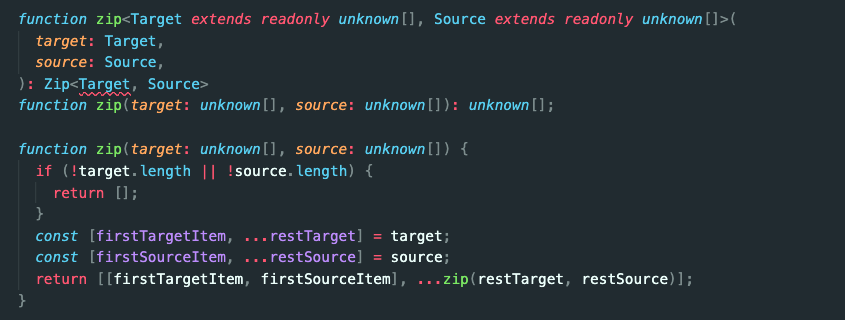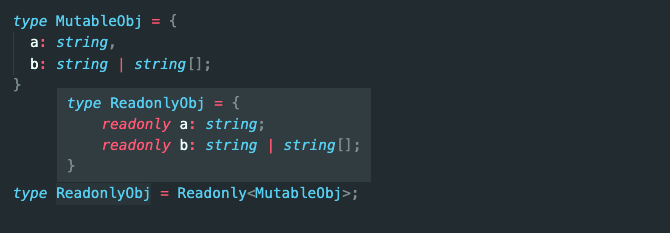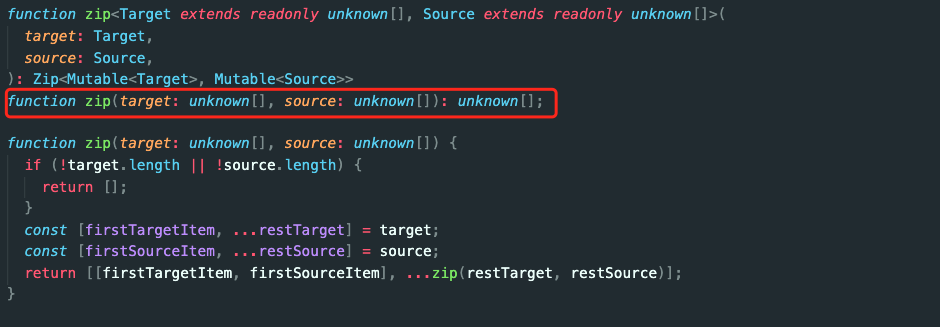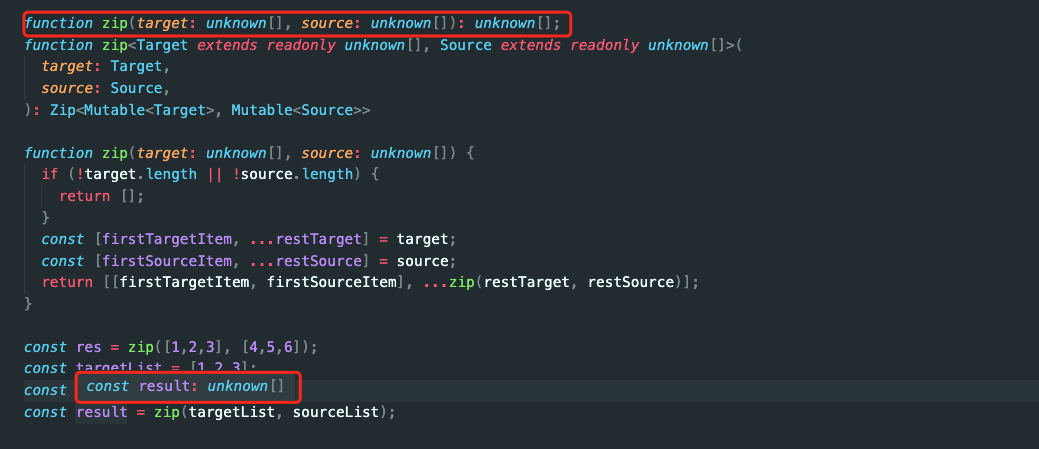一道 3 层的 TypeScript 面试题,你能答到第几层?
前言
本文转载自公众号神光的编程秘籍,对文章作者神说要有光表示感谢~
原文链接:https://mp.weixin.qq.com/s/wWqeF5JJO3WlmBpDIcSuiw
正文
最近遇见一道不错的 TS 面试题,分享一下。
这道题有 3 个层次,我们一层层来看。
第一层的要求是这样的:
实现一个 zip 函数,对两个数组的元素按顺序两两合并,比如输入 [1,2,3], [4,5,6] 时,返回 [[1,4], [2,5],[3,6]]
这层就是每次各从两个数组取一个元素,合并之后放到数组里,然后继续处理下一个,递归进行这个流程,直到数组为空即可。
1
2
3
4
5
6
7
8
| function zip(target, source) {
if (!target.length || !source.length) {
return [];
}
const [firstTargetItem, ...restTarget] = target;
const [firstSourceItem, ...restSource] = source;
return [[firstTargetItem, firstSourceItem], ...zip(restTarget, restSource)];
}
|
结果是对的:

第一层还是比较简单的,然后我们来看第二层要求:
给这个 zip 函数定义 ts 类型(两种写法)
函数的定义有两种形式:
直接通过 function 声明函数:
和声明匿名函数然后赋值给变量:
而参数和返回值的类型都是数组,只是具体类型不知道,可以写 unknown[]。
所以两种函数类型的定义就是这样的:
1
2
3
4
5
6
7
8
| function zip(target: unknown[], source: unknown[]): unknown[] {
if (!target.length || !source.length) {
return [];
}
const [firstTargetItem, ...restTarget] = target;
const [firstSourceItem, ...restSource] = source;
return [[firstTargetItem, firstSourceItem], ...zip(restTarget, restSource)];
}
|
1
2
3
4
5
6
7
8
9
10
11
12
| interface Zip {
(target: unknown[], source: unknown[]): unknown[]
}
const _zip: Zip = (target: unknown[], source: unknown[]) => {
if (!target.length || !source.length) {
return [];
}
const [firstTargetItem, ...restTarget] = target;
const [firstSourceItem, ...restSource] = source;
return [[firstTargetItem, firstSourceItem], ..._zip(restTarget, restSource)];
}
|
也是直接 function 声明函数类型和 interface 声明函数类型然后加到变量类型上两种。
因为具体元素类型不知道,所以用 unknown。
这里可能会问 any 和 unknown 的区别:
any 和 unknown 都可以接收任何类型:

any 也可以赋值给任何类型,但 unknown 不行。

这里只是用来接收其他类型, 所以 unknown 比any 更合适一些,更安全。
这一层也是比较基础的 ts 语法,第三层就上了难度了:
用类型编程实现精确的类型提示,比如参数传入 [1,2,3], [4,5,6],那返回值的类型要提示出 [[1,4], [2,5],[3,6]]
这里要求返回值类型是精确的,我们就要根据参数的类型来动态生成返回值类型。
也就是这样:

声明两个类型参数 Target、Source,约束为 unknown[],也就是元素类型任意的数组类型。
这俩类型参数分别是传入的两个参数的类型。
返回值通过 Zip 计算得出。
然后要实现 Zip 的高级类型:
传入的类型参数分别是两个数组类型,我们同样要从中提取出每个元素合并到一起。
提取元素可以用模式匹配的方式:


所以这个类型就可以这样定义:
1
2
3
4
5
6
| type Zip<Target extends unknown[], Source extends unknown[]> =
Target extends [infer firstTargetItem, ...infer restTarget]
? Source extends [infer firstSourceItem, ...infer restSource]
? [[firstTargetItem, firstSourceItem], ...Zip<restTarget, restSource>]
: []
:[];
|
分别提取两个数组的第一个元素,构造成新数组。然后对剩下的数组递归进行这样的处理,直到数组为空。
这样就实现了我们想要的高级类型:

但你把它作为返回值加到函数上会报错:

因为声明函数的时候都不知道参数是啥,自然计算不出 Zip 的值,所以这里会类型不匹配(如上图)。
那怎么办呢?
可以用函数重载解决:
1
2
3
4
5
6
7
8
9
10
11
12
13
14
| function zip<Target extends unknown[], Source extends unknown[]>(
target: Target,
source: Source,
): Zip<Target, Source>
function zip(target: unknown[], source: unknown[]): unknown[];
function zip(target: unknown[], source: unknown[]) {
if (!target.length || !source.length) {
return [];
}
const [firstTargetItem, ...restTarget] = target;
const [firstSourceItem, ...restSource] = source;
return [[firstTargetItem, firstSourceItem], ...zip(restTarget, restSource)];
}
|
ts 支持函数重载,可以写多个同名函数的类型的类型定义,最后写函数的实现,这样用到这个函数的时候会根据参数的类型来匹配函数类型。
我们用了类型编程的那个函数通过这种方式写就不会报错了。
我们使用下看看:

咋返回值的类型不对呢?

其实这时候匹配的函数类型是对的,只不过推导出的不是字面量类型。
这时候可以加个 as const。

这样类型就不匹配了,所以要在类型参数的声明上也加上 readonly:

但这样 Zip 函数的类型又不匹配了。
难道要把所有用到这个类型的地方都加上 readonly 么?
不用,我们 readonly 的修饰去掉不就行了?
Typescript 有内置的高级类型 readonly:

可以把索引类型的每个索引都加上 readonly 修饰:

但没有提供去掉 readonly 修饰的高级类型,我们可以自己实现一下:
1
2
3
| type Mutable<T> = {
-readonly [P in keyof T]: T[P];
}
|
用映射类型的语法构造个新索引类型,加上个 -readonly 就是去掉 readonly 修饰的意思。
TypeScript: Documentation - Mapped Types (typescriptlang.org)

有的同学可能问了,数组类型也是索引类型么?
是,索引类型是聚合多个元素的类型,所以对象、数组、class 都是。
所以我们把它用在数组上自然也是可以的:

(准确来说叫元组,元组是元素个数固定的数组)
那我们只要在传入 Zip 之前,用 Mutable 去掉 readonly 就可以了:
1
2
3
4
5
6
7
8
9
10
11
12
13
14
| function zip<Target extends readonly unknown[], Source extends readonly unknown[]>(
target: Target,
source: Source,
): Zip<Mutable<Target>, Mutable<Source>>
function zip(target: unknown[], source: unknown[]): unknown[];
function zip(target: unknown[], source: unknown[]) {
if (!target.length || !source.length) {
return [];
}
const [firstTargetItem, ...restTarget] = target;
const [firstSourceItem, ...restSource] = source;
return [[firstTargetItem, firstSourceItem], ...zip(restTarget, restSource)];
}
|
再来试一下:


大功告成!现在返回值的类型就对了。
但还有个问题,如果传入的不是断言常量(as const)的参数,是推导不出字面量类型的,这时候貌似就不对了:

可我们不都声明重载类型了么?
如果推导不出字面量类型,应该匹配这个呀:

但实际上它匹配的还是第一个:

这是因为:

也就是说第一个函数类型是可以匹配到的。
这时候其实只要调换下两个函数类型的顺序就可以了:

为什么呢?因为重载函数的类型是从上到下依次匹配,只要匹配到一个就应用。
全部代码如下:
1
2
3
4
5
6
7
8
9
10
11
12
13
14
15
16
17
18
19
20
21
22
23
24
25
26
27
28
29
30
31
32
33
34
35
36
37
38
39
40
|
type Zip<Target extends unknown[], Source extends unknown[]> =
Target extends [infer firstTargetItem, ...infer restTarget]
? Source extends [infer firstSourceItem, ...infer restSource]
? [[firstTargetItem, firstSourceItem], ...Zip<restTarget, restSource>]
: []
:[];
type Mutable<T> = {
-readonly [P in keyof T]: T[P];
}
function zip(target: unknown[], source: unknown[]): unknown[];
function zip<Target extends readonly unknown[], Source extends readonly unknown[]>(
target: Target,
source: Source,
): Zip<Mutable<Target>, Mutable<Source>>
function zip(target: unknown[], source: unknown[]) {
if (!target.length || !source.length) {
return [];
}
const [firstTargetItem, ...restTarget] = target;
const [firstSourceItem, ...restSource] = source;
return [[firstTargetItem, firstSourceItem], ...zip(restTarget, restSource)];
}
const res = zip([1,2,3] as const, [4,5,6] as const);
const targetList = [1,2,3];
const targetListConst = [1,2,3] as const;
const sourceList = [4,'5',6];
const sourceListConst = [4,'5',6] as const;
const result = zip(targetList, sourceList);
const resultConst = zip(targetListConst, sourceListConst);
|
总结
今天我们做了一道综合的 ts 面试题,一共有三层:
第一层实现 js 的逻辑,用递归或者循环都能实现。
第二层给函数加上类型,用 function 声明类型和 interface 声明函数类型两种方式,参数和返回值都是 unknown[]。
第三层是用类型编程实现精准的类型提示,这一层需要拿到参数的类型,通过提取元素的类型并构造出新的数组类型返回。还要通过函数重载的方式来声明类型,并且要注意重载类型的声明顺序。
as const 能够让字面量推导出字面量类型,但会带有 readonly 修饰,可以自己写映射类型来去掉这个修饰。
其实这也是我们学习 ts 的顺序,我们先要能把 js 逻辑写出来,然后知道怎么给函数、class 等加 ts 类型,之后学习类型编程,知道怎么动态生成类型。
其中类型编程是 ts 最难的部分,也是最强大的部分。攻克了这一层,ts 就可以说学的差不多了。






























.jpg)